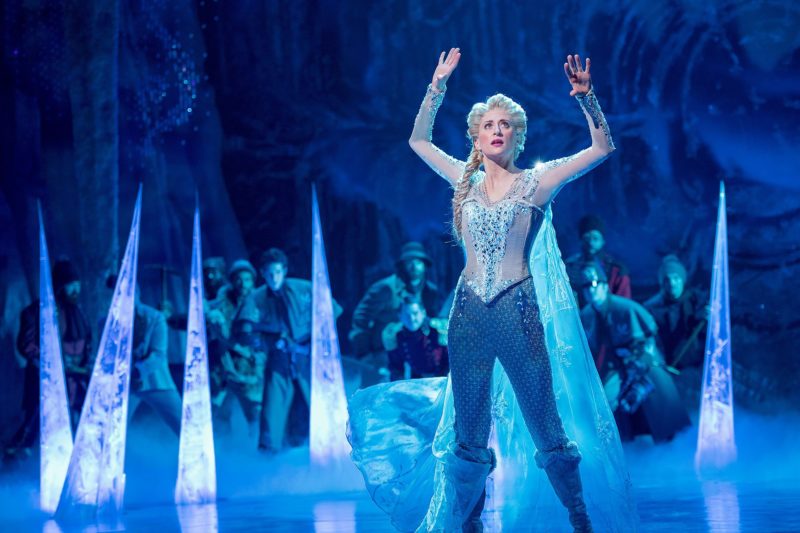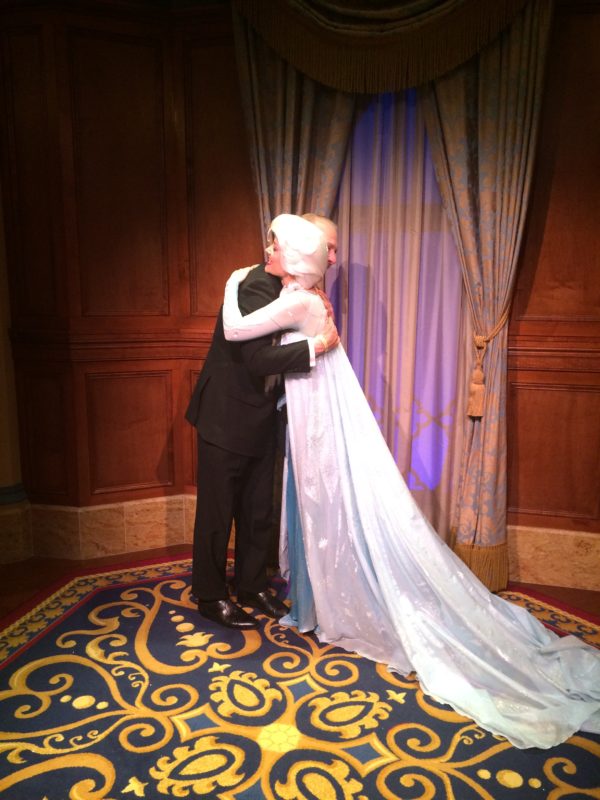Frozen Makes It Rain on Broadway

Great art is also greatly adaptable, in endlessly creative ways. It can migrate from novel to opera to film to soundtrack to theater and back again. The attempt alone is a test of quality, durability, and the skill of those who make it all possible. An example might be the story of Salome which has migrated from Hebrew scriptures to Oscar Wilde’s play to Richard Strauss’s opera to cartoons.
So let’s talk about Frozen.
You can and will take issue with me that the movie Frozen is great art but consider the following. The original Frozen story was supposed to be the Disney version of Hans Christian Andersen’s 19th-century story The Snow Queen. But when the writers first heard the now-famous theme song “Let It Go,” the story changed to adapt itself. Elsa became sympathetic, struggling, and redeemable. The plotline followed the music.
The results from the 2013 film were remarkable, financially and culturally. The sequel, despite my own reservations on its underlying ideological push, is massively popular.
What I could not have imagined is how this movie, which exploits the greatest techniques of modern animation, would translate to the theater. But the production on Broadway has done it. As many reviewers have said, it is in some way deeper and more profound than the movie version, with several new songs. The impact is eye-popping, thrilling, extraordinary.
For this version, some songs were moved around a bit and the fabulous moment of “Let It Go” came just before the intermission. The entire audience just gasped with joy and the opening notes, and for good reason. This is the hymn to individual and community achievement that spontaneously swept the world nearly seven years ago. It remains an essential part of the soundtrack of our times, as child after child becomes obsessed with the film “Frozen” and every single song in it. The demographics of its success endless far beyond the young: the Broadway version I saw was sold out with mostly young adults.
The success of “Let It Go” is based on far more than its beautiful music and compelling performance. Its triumph as popular art tells us something about where we’ve been and where we are headed as a political order and a people.
The story of this song is something magical. You can look at the metrics and see what has happened. A sing-along version online is the most popular with almost two billion views. The original version has 700 million. The other versions in other countries have views in the many millions too. There are countless covers. Of course, there are parodies too. A prominent musicologist made a video explaining why the song is so wonderful. It has won the Grammy and Academy awards.
I can recall my own feelings when I first heard the song in the movie theater. The sense of excitement was overwhelming. It left me breathless at the end. It was amazing. I wondered if others shared my view, and recommended the film to friends. They had the same feeling. There was growing excitement over this all through the holiday season, and it intensified into the new year. And it kept expanding.
During the making of Frozen, Disney Studios had some inkling that the song “Let It Go” — composed in one day by Kristen Anderson-Lopez and Robert Lopez — was going to be big. The original storyline had a placeholder for “Elsa’s Badass Song”, but the result was far more complicated and wonderful.
Disney had no idea how viral this song would become. In fact, before the canonical version sung by Idina Menzel was released, Disney had released another version by Demi Lovato (500 million views). It had different words, and a less challenging musical structure (excerpt for the wonderfully sneaky use of the celesta in the chorus!). It was designed for radio play, with all the conventional features you expect in that genre. It must have come as a shock that the soaring and hyper-dramatic version by Menzel became the mega hit.
Here we see the power and glory of popular culture, defying every prediction and every expert, taking a song from an animated film and turning it into a global anthem that sings of the great themes of our times.
What is the source of power here? Is it just the “you-only-live-once” song of our time? Is it only about one person’s struggle to escape the confinement of social expectations and find freedom? Perhaps, but the extent of the energy behind its popularity suggests something much more robust is going on here.
The opening segment has Elsa wandering alone on a mountain, walking through fresh snow, like a pioneer seeking out something entirely new and uncertain. It is a dangerous and uncharted world she has entered, and she has entered alone. She is reflecting on what she left. She was supposed to be the queen, so she had spent her life so far complying with her duty. That required her to conceal, to deceive herself and others, not to feel anything real, not to have emotions and ambitions, not to seek freedom.
This is not only about one woman’s struggle. This is the struggle of all people, the whole of the world, saddled down by a failed experiment to manage societies and economies from the top down. It all began about a century ago when governments started aggressively taxing, regulating, blocking, prohibiting, and prodding people in their commercial relationships. As the years have gone by, restrictions and regimentations are not repealed; they are only added to, like bad traditions in aging monarchies, stultifying and suffocating the human spirit.
People once believed that states could restrict themselves to “economic” regulation while not impinging on human freedom more generally, as if economics was somehow a separate field from human choice more generally. But now we look around us and what do we find? Every aspect of our economic lives is touched by imposition from states. To regulate our economic lives means to regulate our lives; to take away our economic liberties is to take away our human liberties.
We cannot keep the money we make. We cannot start enterprises without begging bureaucrats for permission. We cannot buy and sell without constant attention to compliance issues. Every aspect of our interaction with the material world is managed by public employees and their laws and regulations they are charged to carry out. And the prohibitions of modern life are morally and emotionally debilitating. The war on drugs continues on and on despite its incredible cost. The prisons fill up with non-violent offenders. Our every social interaction is watched, captured, and kept to be used against us later.
We are all versions of Elsa in her old kingdom. We are expected to submit, to comply, to keep quiet, to carry out our duties to the political order. Conceal your opinions. Don’t feel. It’s the tyranny of the status quo that people continue to tolerate because no one is permitted to think another way.
But like Elsa, many people are seeing that there is a way out. Once it became obvious to everyone in the kingdom that she wasn’t the right person for the job of queen, she fled the anger of the mob, running across the lake and entering into an unknown realm. It is at first terrifying but then empowering. This is a good description of the harrowing life of entrepreneurship and innovation, of trying new tools in a digital age, of daring to step outside the plan and break free from the crushing regimentation of life under the state.
Leaving the regime and embracing the future with daring determination is precisely what the young generation is doing in a huge range of areas. They are eschewing the plan because the plan no longer works for them. The retirement systems that governments established are a joke. The tax take from our paychecks is a self-evident racket. The many ways that government promised to help us turn out to be just benefits bestowed on insiders.
The whole of the world is caught in a thicket of legacy rules that ensnare us. To comply is to die the death, to give up the essence of what it means to be human. To obey is to give up every dream.
How to break free? Elsa was pushed to the brink. She did what she had to do. She just ran away. She set out to be a pioneer. And once she dealt with the reality that her old community would shun her, she had no real choice but to be true to herself. She found true freedom.
It’s funny how some distance
Makes everything seem small
And the fears that once controlled me
Can’t get to me at all
It’s time to see what I can do
To test the limits and break through
No right, no wrong, no rules for me
I’m free
She made her own freedom by choosing her own way. And so too have multitudes of people in history. Every artist, every entrepreneur, every true innovator must go through the process of breaking free from what exists in order to create something new. Perhaps it means leaving your homeland to find freedom elsewhere, as when Ayn Rand left Russia or Ludwig von Mises left Austria. Perhaps it is purely mentally breaking free. Or perhaps it is that new form of migration we see today in which people are finding freedom in the digital cloud and leaving the physical world as much as possible.
As for the “no right, no wrong” line, it is not an endorsement of some kind of nihilism or relativism. The civic order Elsa leaves is like all civic orders: they invent moral systems and personal duties that are designed to serve the elites, not the people. They are artificial, not extending from the law written on our hearts but are rather created by legislation, bureaucracy, and political interest. Before we can find true morality, we have to shed the fabricated rights and wrongs as imposed by the political elites.
Once having discovered that she can be free, Elsa next must ask the question: what can I do with my freedom? It is the question we all ask. Freedom must find expression in creativity, in the building of something to serve our values. Elsa first makes a fantastic staircase that reaches higher and higher up the mountain, symbolizing her ever-rising aspirations as a person and achiever.
She runs up the stairs with a feeling of wild exuberance. Then she turns to the great task. She decides that this is where she will stand and stay. She builds a glorious and mighty castle out of ice, with fantastic modernist construction, chandeliers, and sweeping lines that leap to the heavens. She feels powerful. Her soul is spiraling. And one thought crystallizes in her mind:
I’m never going back,
The past is in the past.
This passage in the song is sung so clearly, with such decisive drama and certainty, it emerges as the dominant theme in the entire song.
And it is the dominant theme in our digital times, too. We live even more in the globally relevant Internet cloud, this new frontier that broke the mold of the past. It is clearly our future, a pathway to freedom. But governments of the world are intolerant of it. They don’t like its global reach, its structure, its distributed networks that elude control.

But once you have experienced what modernity has to offer, the world that it opens up to you, it becomes incontrovertible: there will be no going back. Whether governments like it or not, the new times are here. Regulations, censors, and surveillors can try to keep the future at bay, try to control that which cannot be controlled but, in the end, they will fail.
Bureaucracies by their nature rule over a world that is in the past. They cannot know, much less manage, an innovative future full of new ideas, new tools, new forms of association. Let the storm rage on. We will not turn back to the old ways. We will not look back. The past is in the past.
As the song ends, Elsa emerges on the balcony and looks out over the world she left. She closes the door on that world, and, we feel, she closes the door on us. This is her mistake. She cannot live in isolation. She must be part of a community to thrive. The remainder of the story is about her discovery of that great truth. She works out a way to invite others into her liberated world.
And so it is with the great cause of human liberation from the strictures and impositions that have so ruined the wonder, adventure, and brilliance of life. We can break free on our own, but it is not enough. We must ask others to join us, to partake in the freedom we have claimed for ourselves. This is in their interest and ours. As the world rediscovers the need to be free — to walk away from that which oppresses us — we will see the flourishing of the human spirit, an unleashing of global energy, and a beautiful thaw will take place.
The world will no longer be frozen. It will be free.
And so this great theme converts from song to movie to musical play to a theme of civilization itself in a world that must always struggle to find the courage to free and find its true self.










